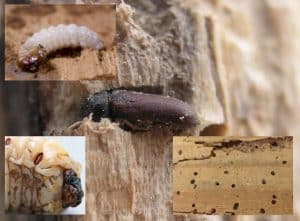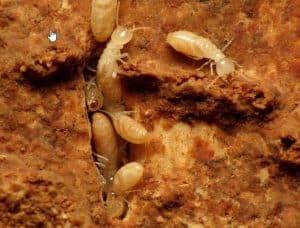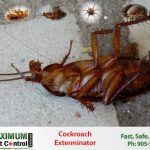
Woodworm or Termite Infestation
While both woodworm or termite infestation pose threats as wood-destroying pests, they are quite different invaders requiring distinct treatment approaches. Mistaking which insect you’re dealing with can lead to ineffective control measures and allow further property damage to occur.
Termites are highly social insects living in colonies that can number into the millions. Woodworms, on the other hand, are the larvae stage of different wood-boring beetle species acting as solitary invaders. From their behavior patterns and warning signs to the most effective extermination methods – woodworm and termite infestations diverge in several key ways. Want to ensure you properly identify which pest has infiltrated and implement the right solution? Read on to understand the critical distinctions.
What Are Woodworms?
The term “woodworm” refers to the larvae stage of several species of wood-boring beetles. These destructive pests hatch from eggs laid inside wooden structures and proceed to tunnel through and consume the wood as they mature over a multi-year cycle. Woodworm infestations can silently cause major damage from the inside out before being detected.
Common woodworm culprits include furniture beetles, deathwatch beetles and house longhorn beetles. While their specific behavioural patterns differ slightly, the end result is the same – they excavate maze-like galleries and tunnels within wooden beams, floors, furniture and more as they feed. This hollows out and weakens the structural integrity over time.
Identifying Woodworm Infestations
While often overlooked, woodworm infestations can silently cause extensive damage to the structural integrity of a home or building. These pests feed voraciously on wood from the inside out, weakening beams, floors, and framing over time. Catching an infestation early is key to limiting destruction before costly repairs are needed. Look for these telltale signs:
Small holes in the wood
Small round exit holes across wood surfaces are a major red flag that woodworms have taken up residence. The powdery wood shavings and frass they leave behind are also clear evidence.
Audible detection
In some cases, you may actually hear the larvae munching away inside wooden timbers in the form of faint scratching or rasping noises.
Adult Insect Sightings
Eventually mature woodworm beetles will emerge to mate and lay new eggs. Spotting these small, cylindrical insects near wooden areas signals an advanced infestation.
Early detection allows for localized treatment before the pests spread and inflict severe structural damage needing major repair work. Regularly inspecting for woodworm signs protects a home’s integrity.
What are Termites?
Termites are highly destructive wood-eating insects that live in colonial societies. These pests cause billions of dollars in property damage each year by voraciously consuming the cellulose in wood, paper, and even plastic laminates. Left unchecked, termites can silently hollow out walls, floors, and structural beams from the inside out over time.
There are several different termite species found across Canada, but the two main groups are subterranean and drywood termites. Subterranean varieties nest in the soil and create mud tubes to travel between their colony and above-ground wood sources. Drywood termites establish whole colonies inside the wooden areas they are consuming.
No matter the species, termites are persistent invaders always seeking new sources of wood to infest. They follow moisture trails from the tiniest cracks into homes and quickly build vast populations of workers, soldiers and reproductives. Identifying the first signs of termite damage allows for early treatment before catastrophic structural failure occurs.
Recognizing Termite Infestations
Termites are one of the most destructive pests that can infest homes and buildings. Early detection is crucial to limiting the severe structural damage they can inflict by hollowing out wood over time. Look for these key signs that signal an active termite infestation:
Identifying Termite Activity
Discarded wings from termite swarmers are an obvious red flag, often found accumulating near windows, doors, or other light sources. You may also spot the insects themselves – pale-colored worker termites transported via mud tubes on the home’s exterior. Tapping on wood and hearing a hollow sound is another indicator of termites eating away the interior.
Other Telltale Signs
Cracked or bubbling paint can reveal termite activity underneath as they excavate tiny galleries through wood framing, flooring and wallboards. Wood that has taken on a honeycomb appearance or seems blistered is likely due to termites infesting from the inside out. Piles of drywood termite droppings resembling sawdust point to an infestation as well.
Take Action Against Woodworms or Termites
Discovering termites or woodworms have infested your home triggers justifiable panic. These voracious pests can quickly do catastrophic damage by relentlessly eating away at the wood framing, floors and structural supports from the inside out. An aggressive response is critical to eliminating the infestation before it compromises the home’s integrity.
The first step is getting a thorough professional inspection to identify the species and locate all impacted areas. Trained experts have specialized tools like moisture meters and borescopes to inspect hard-to-reach spaces. Once the full extent is mapped out, they can develop an effective extermination and treatment plan tailored to the situation.
Options may include liquid termiticides, baits, wood injections or even tenting and fumigation for severe infestations. Addressing potential moisture problems and repairing termite/woodworm damage prevents future re-infestation.
Conclusion
Accurately identifying whether your home is facing a woodworm or termite infestation is the crucial first step in mounting an effective response. These wood-destroying pests require quite different treatment approaches to eliminate. Misdiagnosing the invader could allow devastating damage to continue unchecked.
While both leave behind signs of their presence like exit holes, galleries, and wood damage, understanding behavioural patterns helps distinguish termites from woodworms. The social termite colonies with mud tubes point to a more widespread infestation requiring comprehensive baiting and soil treatment.
Solitary woodworm beetles may allow for more localized wood injections or replacements. Contact Maximum Pest Control professionals for proper assessment and tailored solutions.





